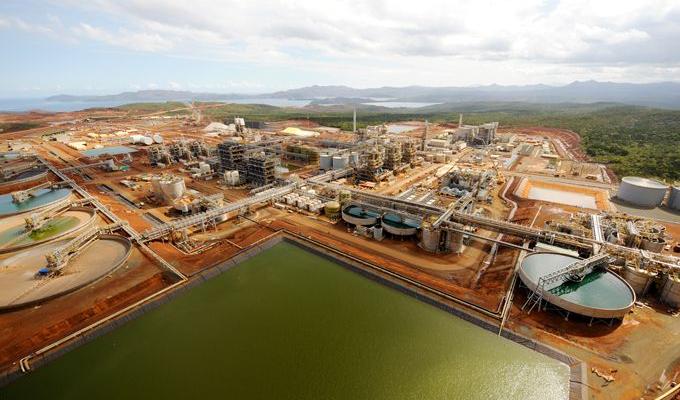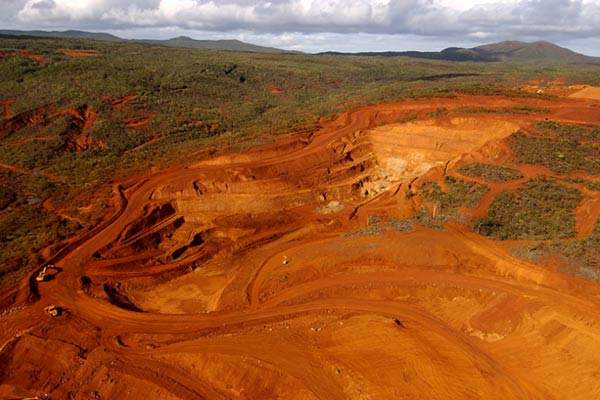Nickel mining in New Caledonia
Nickel mining in New Caledonia is an important sector of the New Caledonian economy. About 10.3 million tons of nickel are stored on the islands, which is about 11% of the world’s reserves.
With an annual production of 200,000 tons in 2020, New Caledonia was the world’s fourth largest producer after Indonesia (760,000), Philippines (320,000) and Russia (280,000), followed by Australia (170,000) and Canada (150 000).
Nickel production in New Caledonia accounts for 7–10% of the country’s GDP and up to 80% of foreign income. With the exception of tourism, nickel ore and metallurgical derivatives account for about 97% of the total export value.

Story
Nickel was discovered in New Caledonia in 1864 by engineer Jules Garnier. It was distributed in ore beds that cover about one third of the area of the main island of New Caledonia. The nickel concentration was heterogeneous and also varied with depth. If its usual concentration was 2–5%, then in individual green garnierite deposits it could reach 10–15%. These areas were first developed using primitive manual mining methods and gradually depleted, resulting in an average concentration currently of 2.6 percent. This nickel is found at a depth of about 30 meters (98 ft). The shallower layers of 10–20 meters (33–66 ft) also contain nickel, but at half its concentration. They remain untapped and make up the majority of New Caledonia’s nickel reserves.
Large-scale mining began in 1875 in the communes of Huailu and Canal. Previously, mining was carried out manually, and then gradually became mechanized. By the early 20th century, two major mines had been built at Burai and Tio. In the first years after the discovery of nickel, its extraction was carried out at about 330 mines. However, in 1981 there were only 30 mines, compared to 130 in the early 1970s. Due to the remoteness of the islands, about half of the ore was smelted locally, despite New Caledonia’s underdeveloped industrial infrastructure. The other half was exported, mainly to Japan. The first nickel plant was built in 1879, the other two in 1910 and 1913. The smelted product contained about 70–80% nickel and was sent for refining to France. Due to the low content of nickel in the ore, local smelting has led to the displacement of a large amount of rock near the smelters, which has changed the local landscape.
In the 1930s, white “Caldoches” and companies like Société le Nickel dominated the colony’s economy. Native Melanesians lived on reservations, which made up only 10 percent of New Caledonia’s territory. The main source of mine labor was Asian migrants employed by France. The arrival of these migrants from India, Japan, China, Java and Vietnam increased and changed the demographics of New Caledonia’s population. By the 1920s, the Asians outnumbered the French.
Between 1875 and 1948, ore production was almost constant, but then increased by about 70 times, peaking at 8 million tons in 1971, when New Caledonia was the world’s second largest nickel producer. In the second half of the 1960s, the nickel industry saw a boom in demand associated with the Vietnam War. [9] New Caledonia’s exports have quadrupled in the past decade. This increase was followed by a decline to about 4 million tons of ore in 1981 due to cyclones, lower demand for the metal, and an increase in the role of other global producers such as Indonesia, the Philippines and Australia. Accordingly, the mined area decreased from 21,500 to 8,700 hectares (from 53,000 to 21,000 acres), and the number of people employed in the industry from about 6,200 to about 3,600. Almost half of them worked in the mines, and the other half in large processing plant Doniambo near Noumea.
Mines
Open pit mining is the most common technology used for nickel mining, and statistics show that 500 million tons of overburden had to be removed to extract the nickel ore, amounting to a clearing of 20 hectares (49 acres) per million tons (five million tons). tons of ore per year form 25 million tons of tailings).
The local nickel industry is dominated by the French company Eramet, which owns a 60% stake in its nickel mining subsidiary SLN (Societe Le Nickel) in New Caledonia. Other firms such as Falconbridge Ltd. , Inco , Argosy Minerals and QNI, however, are still active in New Caledonia, notably Inco at the Goro mine, which produces nickel and cobalt, about 54,000 tons of nickel annually.
Despite declining nickel production, New Caledonia remains one of the world’s largest producers of laterite, a source of ferronickel (an alloy of iron and nickel), which accounts for about 20% of the country’s production. Another 80% is nickel recovered from saprolite. In 2008, New Caledonia’s ferronickel was mainly exported to the European Union (41.8%), Japan (18.2%), Taiwan (18.2%), China (8.0%), India, South Africa, South Korea (2.4%). %) and the USA. On the contrary, all smelted nickel is sent to France.
The main mines are Goro, Thio, Conyambo, Cuaua, Nepouy-Copeto and Etoile du Nord. The new Thiebagi mine has recently been opened, which will account for about 30% of SLN’s annual production, which is 20,000 tons per year.

Mining and nickel plant
The Goro Mine is one of the largest hydro-smelters built, valued at $3.2 billion, with a design capacity of 60,000 tonnes of nickel per year. Nickel is mined from laterite with proven reserves of 120 million tons. Cobalt is also mined here from saprolite deposits. Open pit mining is underway to depths of 50–60 m (smaller seams have no commercial value). The main share in the plant belongs to a consortium with Vale Inco (Brazil), which owns 69% of the shares, and a joint company of Sumic Nickel Netherlands, Japanese Sumitomo Metal Mining Co. Ltd. and Mitsui Co. Ltd., owning 21%. Share. However, in 2020, Vale is selling all of its mining interests to New Century. The remaining 10% belongs to the three provinces of New Caledonia. The project was halted for a while as the local Kanak community strained against the project, in particular the laying of a sea line. As of 2014, lagoon pollution was a problem and there were shutdowns.
